
Table of Contents
Who Was H.H. Holmes?
Herman Webster Mudgett, infamously known as H.H. Holmes, was a notorious con artist and bigamist, often recognized as one of America’s earliest serial killers. Dubbed the “Beast of Chicago,” Holmes is believed to have murdered between 20 and 200 individuals. Many of his heinous acts were carried out in a meticulously designed residence that earned the moniker “Murder Castle.” Arrested in 1894, Holmes was executed by hanging for his crimes two years later. His macabre activities served as the inspiration for the best-selling book The Devil in the White City.
Early Life
H.H. Holmes, originally named Herman Webster Mudgett, was born on May 16, 1861, in Gilmanton, New Hampshire. Raised in a prosperous family, Holmes experienced a privileged upbringing and exhibited exceptional intelligence from an early age. However, troubling signs of his future criminal tendencies emerged early on. Holmes developed an early interest in medicine, which led him to conduct surgical procedures on animals. There are also accounts suggesting he may have been involved in the death of a friend.
Holmes’ criminal activities began with various fraudulent schemes. While studying medicine at the University of Michigan, he engaged in grave robbing to obtain corpses for the purpose of making fraudulent insurance claims. There is also speculation that he may have used these bodies for experimental purposes.
The Infamous “Murder Castle”
In 1885, H. H. Holmes relocated to Chicago and soon found employment at a local pharmacy under the alias Dr. Henry H. Holmes. After acquiring the business, he was rumored to have murdered its original proprietor.
Holmes subsequently commissioned the construction of a three-story building nearby, which he meticulously designed to serve as a grisly “house of horrors.” The upper floors housed his living quarters as well as numerous small, isolated rooms where he inflicted torture and executed his victims. The building was equipped with trapdoors and chutes that allowed him to transport the bodies to the basement, where he could incinerate them in a kiln or dispose of them through other methods.
During the 1893 Columbian Exposition, Holmes converted his residence into a hotel for the influx of visitors. Tragically, many guests did not survive their stay in what came to be known as the “Murder Castle.” While the exact number of victims remains unknown, it is believed that many were women whom Holmes deceived and then killed. He often proposed to his victims, only for his fiancées to mysteriously vanish. Others were drawn to the hotel under the pretense of job opportunities, only to meet a similar fate.
Fraud Scheme
After departing Chicago shortly after the World’s Fair, Holmes continued his fraudulent activities, collaborating with an accomplice named Benjamin Pitezel. Their scheme involved staging Pitezel’s death to secure a $10,000 payout from a life insurance policy.
During a subsequent incarceration for unrelated fraudulent activities, Holmes, under the alias H.M. Howard, confided in Marion Hedgepeth, a notorious outlaw. Hedgepeth, who was also imprisoned, was informed about the life insurance plot and later assisted investigators by disclosing details of their conversation.
Although authorities eventually connected Howard to Holmes, their investigation was not swift enough to prevent his final acts of murder. Holmes killed Pitezel and, after deceiving Pitezel’s widow into believing her husband was alive and in hiding, persuaded her to allow him to travel with three of her five children, who subsequently became his victims.
Arrest
After eluding authorities for several weeks, Holmes was apprehended in November 1894. While in custody, he provided a multitude of statements to the police, at one point confessing to the murder of 27 individuals. Convicted in 1895, Holmes subsequently appealed his case, but the appeal was denied.
Estimates regarding the total number of Holmes’ victims vary significantly, ranging from 20 to as many as 200.
Death
Holmes passed away on May 7, 1896, when he was executed by hanging for the murder of Pitezel. At the time of his death, he was approximately 34 years old. Known infamously as the “Beast of Chicago,” he was interred in Philadelphia.
Inspiration for Devil in the White City
Erik Larson’s The Devil in the White City (2003) delves into the life of H.H. Holmes, one of America’s earliest serial killers, a subject that has been extensively explored in numerous books and documentaries. The book has been the focus of multiple adaptation efforts for the screen over the years, with notable figures such as Leonardo DiCaprio, Martin Scorsese, and Keanu Reeves attached to the project at different stages. Most recently, there was an attempt to develop a limited series for Hulu; however, the streaming service decided to discontinue the project in May 2023.
